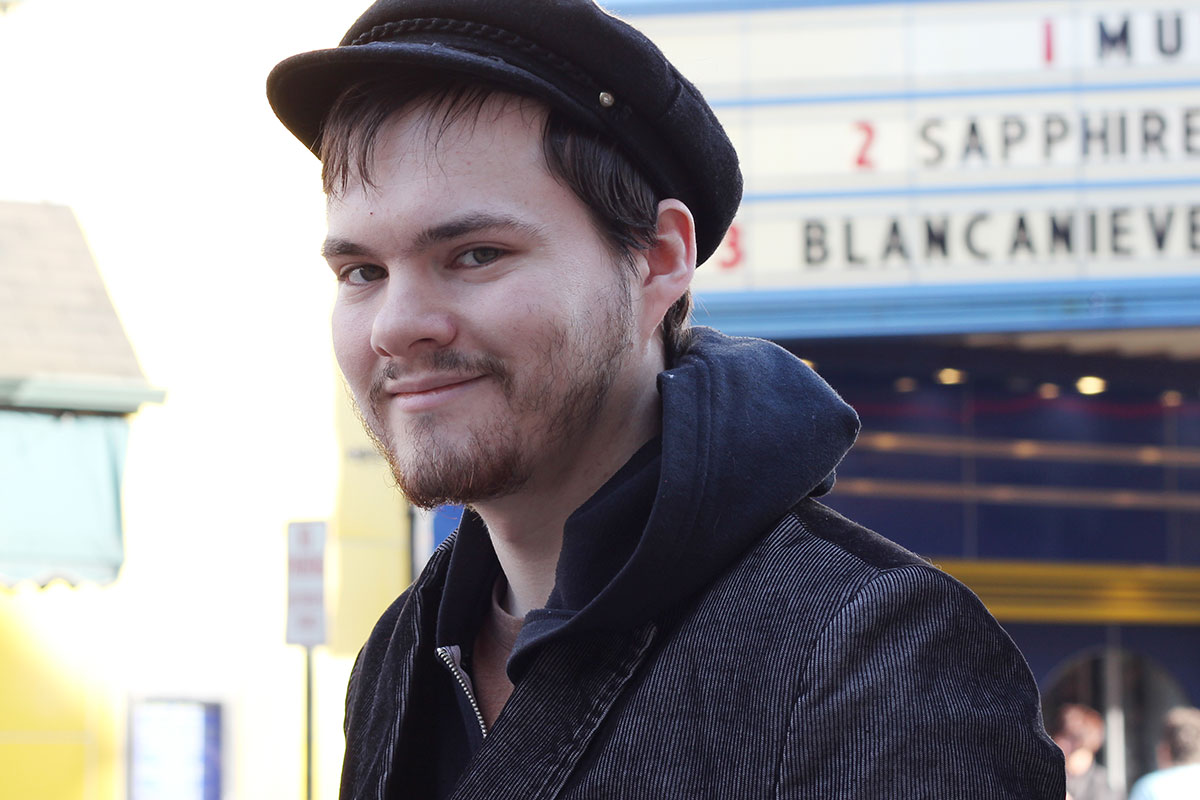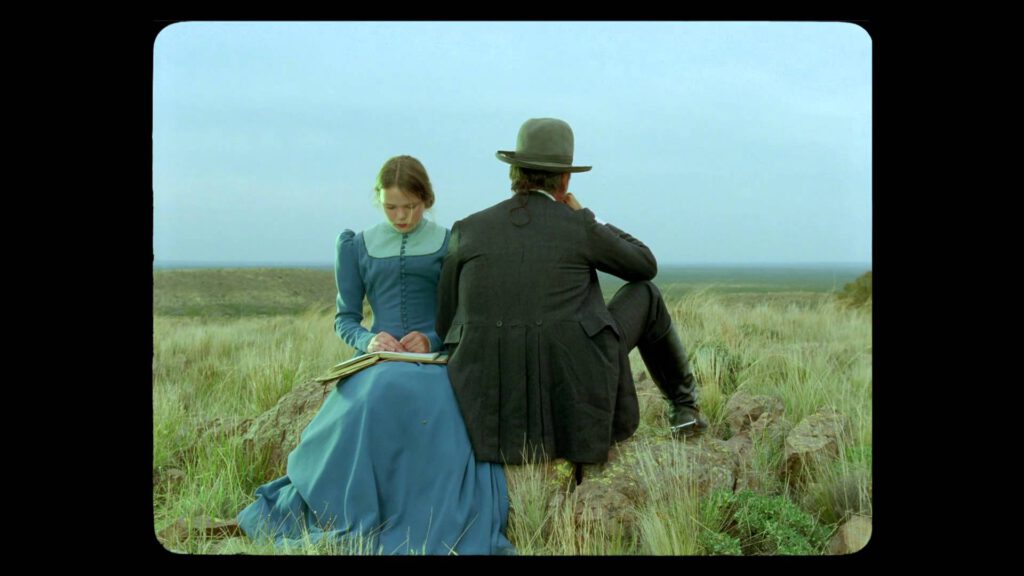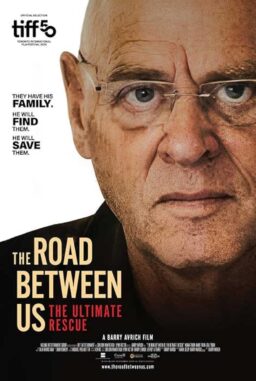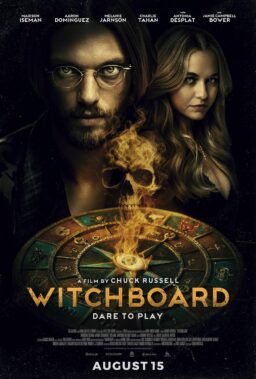Towards the end of
Lisandro Alonso’s haunting fourth feature and first masterpiece “Jauja,” a
disembodied voice asks, “What is it that makes a life function and move
forward?” The question is a cunning bit of misdirection, because at that
moment, the movie shifts focus and leaps around in time. The line ought to make
sense of what’s come before it, or at the very least explain what happens next.
Really all it does is change the tenor of the film’s slightly hallucinatory
exhaustion. The answer is irrelevant because the film finds only this: Men will
always convince themselves that what makes life move forward is consuming and
subjugating everything in sight. As one European colonialist narrative after
another has shown, that’s progress with a half-life and life ceases to function
if given over to such pursuits. Men who fancy themselves explorers and
conquerers wind up alone, lost, raving, half or entirely mad. Viggo Mortensen’s Danish explorer, is only the latest in a long line of foolhardy men who lose
their way while attempting to smooth out a land that will not be tamed. “Jauja”
positions itself as a continuation and answer to films like “The Story of Adele
H.”, “A Girl Is A Gun,” and the films of Werner Herzog, grammatically as well
as in their bruising ideology.
The opening text
tells us what Jauja is; a kind of Incan El Dorado, a mythic place that ensnared
all who went looking for it. “The only thing that is known for certain is that
all who tried to find this earthly paradise got lost on the way.” Mortensen’s
Captain Gunnar Dinesen doesn’t go looking for paradise, or gold. His government
has sent him to Argentina to shape, map and cut up the land while the savage
troops whose aid he’s come to have begun annihilating the indigenous people.
Dinesen is a product of an empire’s arrogance: he’s just one of a second wave
of workers sent to a land that the Danish believe belongs to them. That was a
special trait that Europeans possessed: to believe steadfastly in their right
to own that which they discover. Cinema in the 1970s is full of images of men
tramping across vast expanses of land, looking like biblical conquerers about
to either lay waste to everything beautiful or be swallowed by the elements and
turned into ruins where they stand. The most famous and haunting of these must
be in Werner Herzog’s “Aguirre, The Wrath of God.” In the opening shots, a
hundred conquistadors traipse through miles of dense rain forest, believing
their armour and conviction will protect them even as they drop their supplies
left and right. The grand design of their self-appointed leader (Klaus Kinski) evaporates with every mile they trek into the jungle and he winds up alone and
half-mad, adrift on a river. Dinesen’s journey is metaphysically identical,
except that he makes it on behalf of his nation by accident.

The ostensible
purpose of Dinesen’s trek into the unknown is that his daughter runs off with a
young soldier. Most of this is communicated without language. Their actions,
like their ultimate path, are elemental. The young girl goes with the handsome
soldier because that is what must happen. That is what draws a rift between
father and daughter. In Francois Truffaut’s “Story of Adele H.”, Adele Hugo is
at odds with her father, the writer Victor, because she has gone to Halifax to
marry a lieutenant she is infatuated with (a crueler spin on Dinesen’s
daughter’s abandoning him). Hugo, a beloved French writer, whose funeral,
Truffaut tells us, was attended by nearly everyone in Paris, stands in for his
nation. The colonies in Canada and Barbados to which Adele follows her
lieutenant, are in the process of becoming children their father cannot
control. Rather like Adele herself. “I was born of a father unknown,” she
writes in her journal. Colonies rebelling against their oppressors is,
unfortunately, just a natural part of forming a cultural identity for many
countries. Just as slavery and exploitation come naturally to empires. Their
impulses can’t mesh, and their meeting is never easy or peaceful. “Jauja” and
“Adele H.” take as their central visual motif images of their heroes climbing
around rocky terrain, dressed in unwieldily finery as if for a ball they
haven’t been invited to, looking for countrymen who will provide them with the
sense of a home they’ve left behind.

Dinesen’s uniform
is a fascinating part of his character. Just after discovering his daughter has
fled with the young soldier, Dinesen grabs his gun and puts on his dress
uniform just as if he were preparing for battle. The uniform is what ties all
conquerers together. It makes them feel right and just, that they bring the
might of their nation with him. He swims in the giant uniform, and later when
he is lost and confused, clearly curses the extra burden it puts on him. He
sweats profusely and has to wet a cloth to put on his head just to make walking
through the desert bearable. It betrays him, just as in a scene where Adele’s
lieutenant discovers a note hidden in his coat, placed their without his
knowledge. Suddenly the uniform, the symbol of his allegiance to a country, has
been invaded. Soon after, his position is threatened because of Adele’s plot to
entrap him into marriage. Patriotism is never protection and uniforms are
just costumes and the layers of masquerade are almost too many to count. Viggo
Mortensen is an artist who pretends to be a movie star, an American Dane who
spent much of his childhood in Argentina playing a Dane who must also speak
Spanish. Dinesen is an engineer who must pretend to be a soldier and a cowboy
in a land that is only pretending to have relinquished its freedom to his
people. Dinesen’s counterfeit cowboy recalls the wiry hero of Luc Moullet’s “A
Girl Is A Gun.” Moullet was a critic and theorist as well as a filmmaker, and
his cowboy (played by wiry Nouvelle Vague icon Jean-Pierre Léaud at his most
irreverent) is a walking construct, entirely aware he doesn’t belong in the
genre. He’s as much a tourist in the Western as he is on the hills occupied by
poorly costumed French indians. Moullet extracts the elements needed to look and
sound like a western even as he deconstructs its trappings. His is perhaps the
most naked of the theoretical, theatrical westerns made in response to the
traditional westerns of the 50s and 60s (and not just American westerns or
Spaghetti westerns. Germany, Russia and the Czech Republic all had their own
straight Westerns. For every “A Girl Is A Gun”, there was an “Ulzana” or
“Apachen” starring Gojko Mitić, the Yugoslavian Randolph Scott. But that’s a
story for another day). Alonso and Moullet both strip their cowboys of their
bearings and dignity, until they’re left bedraggled, chewed up and spit out by
a metaphorical enemy they don’t understand.

The fate of all of
these explorers is the same. There can be only one ending to this narrative, no
matter the variation. Werner Herzog told the story of dozens of Europeans
attempting to carve a home out of a strange country, and they all end in
madness. He made it clear that these men were not welcome with a few simple
tricks. He frequently used pastel-heavy Eastmancolor and rarely lit more than
he had to, relying on the sun to illuminate the alternately dreary and exotic
locales in which he found himself. His camera sometimes moved with his
characters, but it was most frequently still, a calm observer in thrall to the
charismatic maniacs leading the charge into the unknown. The stillness allowed
his characters to penetrate the Z and Y axes, breaking the spell of the
extraordinarily calm of his frame. They’re intruders not just in foreign
countries, but in the order of every composition they tentatively occupy. The
simplest movements seem especially erratic and spontaneous in Herzog’s movies;
nature, creation itself, can be so still and every gesture that takes them from
their place in the frame feels like one step closer to sealing their doom.
It
always helped that his actors never felt like they had planned anything.
Herzog’s favoured performers Klaus Kinski, Clemens Scheitz, Bruno S., Roland
Topor and Isabelle Adjani are free of ordinary mannerisms, and often come to
screaming, jerky life when you least expect them to. That quality was probably
what led Truffaut to cast Adjani as Adele Hugo. Her madness was hidden behind
intense, honest eyes. As she walks, defeated and broken through the streets of
Barbados at the conclusion of “The Story of Adele H.”, her dress torn and her
eyes attempting to fathom isolation even as all around her bursts with motion,
she has finally succumb to insanity and defeat. Mortensen follows perfectly in
her footsteps. When we’re introduced to him, his body language suggests
uncertainty, as if every inch he manipulates his limbs beyond what he feels
necessary causes him great discomfort. His movement seems to break some
unspoken continuity in each of Alonso’s frames, possessed of the same stillness
that imbues Herzog’s compositions. There is a spatial continuity between
“Jauja” and “Aguirre, The Wrath of God” or “Stroszek” that spells Dinesen’s
fate before any sign of conflict has reared its head. Mortensen, Kinski, Adjani
and Bruno S. all gesture in the same tortured way in the center of calm, dully
lit, all-but-unadorned environments. They are all victims waiting to be counted
among the dead. To become the mythic lost searching for cities of gold.
Dinesen’s final
encounter in “Jauja” is at the cavern-like home of a woman, the disembodied
voice mentioned above. She invites him in, away from a cliff-side plain that
bears an erie resemblance to the ocean floor, and offers him hospitality.
Dinesen asks if the woman has seen his daughter. “What does her mother look
like?” is her cryptic reply. “I’ve always wanted to know.” The woman is the
Argentina itself, and the husband she makes excuses for is the people who once
lived there freely. The ‘mother’ of Dinesin’s daughter could be Denmark, or more
generally Europe. The two women, two countries, will never meet, and can only
ever be at the mercy of the men who think progress and subjugation go hand in
hand and cannot be exorcised from their lives. “Slavery is an element of the
human heart” says Kinski’s grotesque outlaw in Herzog’s “Cobra Verde” just
before he nearly drowns trying to pull a boat out to sea. The ‘heroes’ of these
anti-colonialist narratives believe in the material things they anoint
themselves with, and in the righteousness of the causes they’ve taken up, until
they suddenly and fatally fail them. “What is it that makes a life function and
move forward?” They’ll never know. It’s up to the land to take back what it
can, however it can. “Jauja’s” beautiful epilogue suggests that the land will
always find a way to make itself whole. Explorers, slavers, cowboys, heiresses
and soldiers will only put up a fight for so long.












